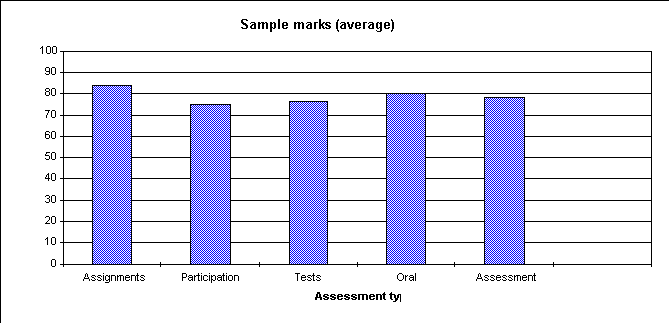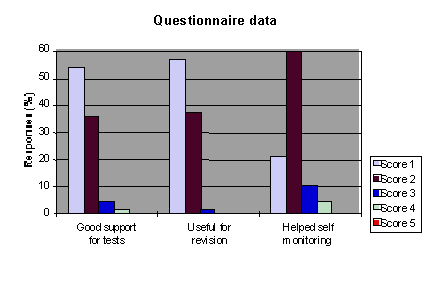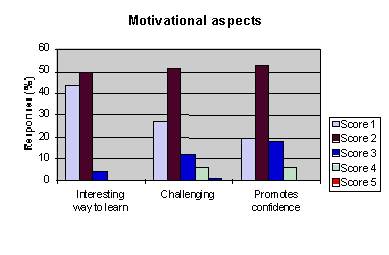Full Paper |
Back to
List of papersIntegrated multimedia for better language learning
Cathy Gunn
ca.gunn@auckland.ac.nz
Centre for Professional Development
The University of Auckland
New Zealand
Abstract
Opportunities for learning with multimedia are changing the focus of course delivery in modern language departments at the University of Auckland. CD ROM based programs are designed to make best possible use of the various media to support theoretically based language teaching and learning strategies, and to integrate with existing course delivery, materials and assessment methods. The decision to custom build multimedia components for specific courses was a deliberate departure from the popular 'add on' approach, where CAL products are offered as a general practice facility for vocabulary and grammar structure acquisition. Designing programs as an integral part of existing courses rather than buying in existing ones was initially a high cost option. However, ongoing evaluation has proved it to be highly effective in terms of improved learning outcomes, course management and general perceptions of the educational potential of multimedia.
Development Context
All the multimedia development projects referred to in this paper conformed to the 'shoestring budget' model which is currently so familiar in academic circles. In most cases, one course tutor worked in collaboration with a programmer from the Language Labs, and had little initial interest or support from other departmental staff. All suffered the familiar problems of limited time and resources, with one individual expected to fulfil many functions for which they were largely untrained. Despite these difficulties, quantitative and qualitative evaluation data gathered from a variety of sources over a two year period shows that development and integration initiatives have successfully achieved the enhanced quality of learning and self management objectives for which they were originally conceived. Expert review suggests that program design has achieved high standards in all respects. Two CD ROMS are currently entered for international software awards, and negotiations are underway with a major US publisher to market an Italian language teaching CD ROM as a package with the textbook it was designed to complement. This paper describes the process which lead to success from such conceptually rich but otherwise humble beginnings.
Why Multimedia?
"Language teachers have long been searching for effective and efficient ways to render the learning experience in class as true to life as possible and to assist students in developing the necessary independent study skills" (Brussino 1996).
This search for effective teaching and learning methods has progressed through the use of various media, including text, radio, broadcast TV, audio and video tape and early incarnations of computer assisted learning. Text and work books are useful for some aspects of drill and practice, but they neglect the need for meaningful, learner generated written and verbal communication in practical contexts. The behaviouristic approach of audio tape based language lab proved equally limited and unchallenging, as well as being methodologically outdated and irreconcilable with the pedagogy of language learning in the 90s, (Lyman-Hagar 1992). TV and video still demand a passive, spectator like mode of study which does not produce the purposeful interactions with real audiences and active learner involvement which recent studies have found to be most effective, (Egbert & Jessup 1996). While each of these delivery modes has a useful place, none has provided an entirely satisfactory solution to the problems of teaching a language to students who are both culturally and practically isolated from the countries where it is spoken.
Computer assisted language learning (CALL) has made significant advances towards finding a solution and to changing the way that language course are conceived and taught. Early CALL developments tended to follow behaviouristic pedagogies and produced electronic imitations of drill and practice workbooks which added some novelty value and usually little else. With the communicative theories of the 1980s came the realization that emerging technologies could support development of learning environments which were culturally and experientially much richer. The outcome was 'communicative CALL', and the first real steps toward opportunities for language learners to communicate and receive immediate, meaningful feedback.
The 1990s will be remembered for the advent of the high powered multimedia desktop computer, virtual reality and the Internet. Developments associated with this phase have been labelled 'integrative CALL', (Werschauer 1996), and involve placing the learner in close to authentic situations where learning simultaneously involves listening, seeing, reflecting, doing and participating. The culmination of these technological developments is a sophisticated tool set which supports creation of rich environments for active learning (REALs), (Grabinger & Dunlap 1996). However, creative effort and technological expertise as well as systematic evaluation must be invested in the conceptual and pedagogical aspects of learning design if the benefits now offered are to be fully realized. The UK Open University and others, (e.g. Eisenstadt 1995), use the term 'knowledge media' to describe the convergence of computing technology, telecommunications and cognitive science and it is from this emerging discipline that the theory and practice of effective learning for the next decade will evolve. The synergy between learning and technology has already been the focus of enough research to know that the potential exists for a complete rethink of the way learning is defined and achieved.
Computer assisted language learning can now provide endless opportunities for interaction with a rich set of media types, characters and cultural information. It can also promote greater autonomy among learners, and is one of few methods yet discovered to make the unavoidable rote learning aspect of language acquisition interesting and motivating. However, an early review of existing software products served as a strong reminder that this potential is often a long way from realization. Most available products were based on old learning strategies implemented in electronic format. Although this may no longer be true, in 1993, the 'new generation' of integrative CALL was still definitely in its infancy. Consequently, it was decided that the necessary educational quality could only be assured through custom design.
Design Objectives
The first major project was initiated by the Department of Italian and is described here as the model which later developments followed. The conceptual design was for a set of multimedia programs that supported what was learned through classroom and social interactions, from the textbook and other course materials. Only through custom design was it possible to match the content, pace and level of the existing course. A major aim was to increase the amount of cultural understanding gained by students, and the unique capabilities of multimedia proved ideal for this purpose. Music, video and audio taped interviews, everyday conversations, shots of famous locations, architecture, artefacts, typical local scenes and characters were all used to present cultural information. Collection of these materials was a costly and time consuming process involving steep learning curves for the production team of two, in aspects such as video capture, sound production, graphics work, live interview techniques, copyright clearance and complex programming. However, it also involved one very interesting overseas trip and broad based experience of media production which subsequently helped teaching staff to form realistic future expectations. The end product is infinitely re-usable in flexible formats, needs no further copyright clearance for any purpose, and may yet prove to be commercially viable.
Other aims were to provide a relevant, challenging and non-threatening environment which motivated students to communicate, to reinforce their learning, and to become familiar with situations and cultural notions that may be encountered in everyday life. To achieve these aims, carefully designed and selected media clips were integrated into a wide range of exercises and interaction styles, including :
In most exercises, the emphasis was placed on provision of opportunities to reinforce and revise the use of vocabulary and grammar structures learned at particular stages of the course. In keeping with the communicative functional methodology underpinning the course, these opportunities were presented within practical contexts which are rich in cultural information. As noted above, most of the video, audio and graphics were produced to fit with the content and the context of particular lessons. This guaranteed the relevance of content material, and allowed exposure to appropriate accents, regional characteristics and customs. As well as being aesthetically pleasing, the wide range of exercises and interaction styles offers variety and demonstrably helps to sustain learner interest. This range of styles has been refined over a number of years, and now provides templates for programs in Korean, Spanish, French, German, Maori, Chinese, Japanese and Russian as well as Italian.
Evaluation
A number of evaluation studies have focused on the relative merits of different integration strategies, and on implementation of various educational and functional aspects of the programs. The studies relied mainly on qualitative methods for various reasons, partly because of the formative and iterative design processes that were being served, partly because of the depth of detail required and partly in recognition of available opportunities and the need to evaluate in authentic contexts, (Draper et al 1996, Gunn 1996). Data sources include :
Reasons for the success of the design related integration strategy provide the focus of another recent publication, (Gunn & Brussino 1997). Evaluation of the educational and functional aspects of the programs resulted in some modifications, although the findings were mainly positive when measured against the original design objectives. To reiterate these objectives, the intention was to extend the scope of existing learning environments to include greater cultural understanding, and to promote more effective communication and independent learning skills.
One issue which has yet to be fully resolved is how assessment of studentsí cultural understanding should be made. This has not previously been included in the course assessments and is not explicitly covered at present. However, since it is now included in the course objectives, ways of changing the assessment structure to reflect this are being considered. This is only one reason that results of the various forms of course assessment cannot be subject to meaningful comparison with those of previous years. However, the overall picture suggests that the quality of learning outcomes is consistently high when a multimedia element in included into courses. Assessments typically include written and oral exams, a continuous series of tests, assignments and participation in conversation classes. Figure 1 shows sample, average results (n=129) from stage 1 Italian the year the multimedia element was introduced.
The ideal situation appears to be where multimedia lab classes are scheduled into course timetables with open access at other times, subject to availability. Log in statistics showed regular use of the programs by a majority of students, both during and outside scheduled class times. The open access option proved a popular one, particularly before test and exam dates, although the level of uptake appeared to depend on how the option was presented to students, (i.e. wholly optional vs strongly recommended). The fact that the programs were considered useful for revision was confirmed by questionnaire data as shown in figure 2.

Figure 1 : Sample marks for course including multimedia
An additional benefit was that students became increasingly comfortable with the concept of autonomous study, an observation which is supported by the question on self monitoring, also shown in figure 2. High levels of motivation and interest appeared to be maintained throughout the semester, and figure 3 shows some indication of this, again taken from the questionnaires.
Other evaluation data suggests that the richness of the learning experience is enhanced by the multimedia programs, and that demands on staff time can be reduced. In the latter case, the number of contact hours for regular courses has been somewhat reduced because tutor assistance is rarely needed in the labs.
Perhaps the most important ëvictoryí is that expectations in terms of quality and characteristics of learning are beginning to change as a result of the integration of a custom built, multimedia element into courses. Now the potential to enhance language learning has been demonstrated, staff in the departments have changed their previously neutral or negative perceptions and begun to conceive of ways that multimedia could improve courses in other areas.
Conclusions
The range of experience described in the current literature, suggests that the reasons for such positive outcomes in this case are a combination of the high educational and design quality of the multimedia programs, and the fact that they are fully integrated into course structures. Although there is currently no guarantee that programs designed for such specific purposes will be useful outside the context they were developed in, the interest shown by the publisher of the Italian textbook is a positive sign. There must be many cases where courses could be designed around the educationally superior multimedia resources that are now becoming more widely available.
As well as providing a ëblueprintí for future developments in other language departments, the experience described in this paper is a useful model for CAL development in other subjects. The evolutionary and integrative approach is proposed as an effective model for progress towards the technology supported, autonomous and flexible learning options which many teaching departments and institutional strategic plans aspire to, but few have so far achieved.

Figure 2 : Usefulness of multimedia programs

Figure 3 : Perceptions of motivational aspects of multimedia
References
Brussino, G. (1996). Developing a Multimedia Component For a Foreign Language Course (Occasional Paper No 7). Institute of Language Teaching and Learning, University of Auckland.
Draper, S. W., Brown, M. I., Henderson, F. P., & McAteer, E. (1996). Integrative Evaluation: An Emerging Role for Classrom Studies of CAL. Computers and Education, 26(1-3), 17-32.
Egbert, J., & Jessup, L. (1996). Analytic and Systematic Analyses of Computer Supported Language Learning Environments. TESL-EJ, 2(2), 1-24.
Eisenstadt. (1995, 7th April). Overt Strategy for Global Learning. Times Higher Education Supplement Multimedia Section, pp. vi-vii.
Grabinger, S., & Dunlap, J. (1996). Rich Environments for Active Learning : A Definition. ALT-J, 3(2), 5-34.
Gunn, C. (1996). CAL Evaluation : What Questions Are Being Answered? Computers & Education, 27(4), 57-60.
Gunn, C., & Brussino, G. (1997). An Evolutionary Approach to CAL. Active Learning, 6.
Lyman-Hagar, M. A. (1992). Towards a New Pedagogy. IALL Journal of Language Learning Technologies, 25(2), 7-13.
Werschauer, M. (1996). Computer Assisted Language Learning : An Introduction. In S. Fotos (Ed.), Multimedia Language Learning . Tokyo: Logos International.
(c) Cathy Gunn
The author(s) assign to ASCILITE and educational and non-profit institutions a non-exclusive licence to use this document for personal use and in courses of instruction provided that the article is used in full and this copyright statement is reproduced. The author(s) also grant a non-exclusive licence to ASCILITE to publish this document in full on the World Wide Web and on CD-ROM and in printed form with the ASCILITE 97 conference papers, and for the documents to be published on mirrors on the World Wide Web. Any other usage is prohibited without the express permission of the authors.

This page maintained by Rod Kevill. (Last updated: Friday, 21 November 1997)
NOTE: The page was created by an automated process from the emailed paper and may vary slightly in formatting and layout from the author's original.